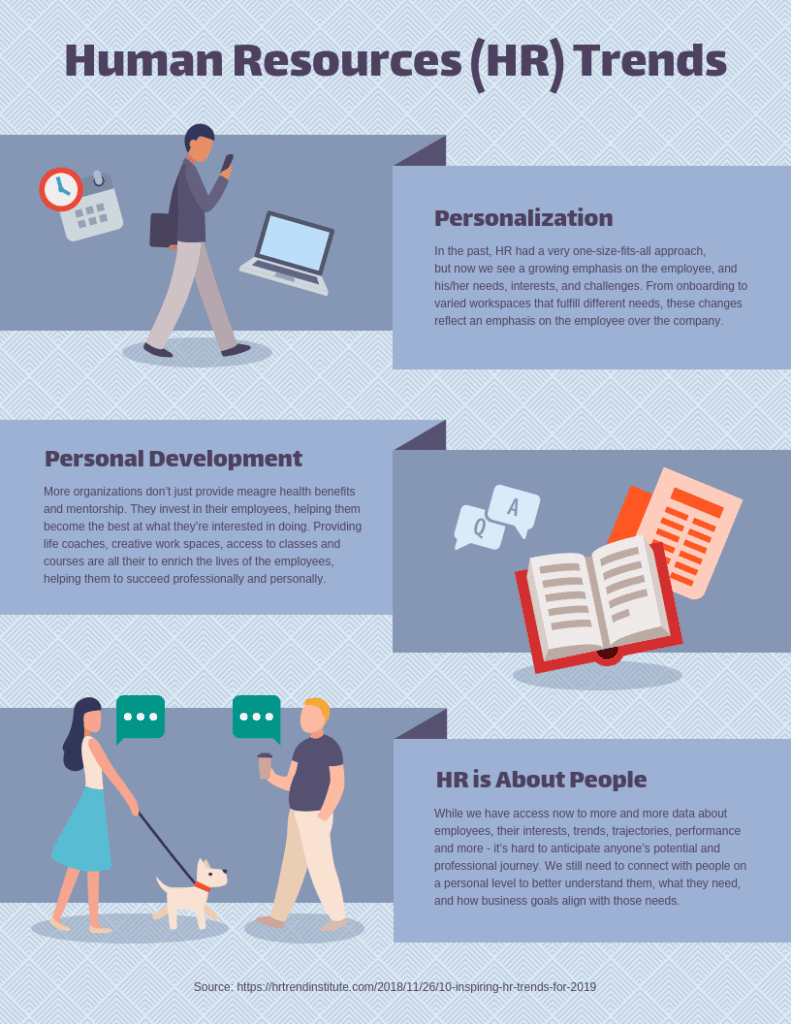Technology has been changing the way we live, travel, order food, and manage our finances. On a daily basis, it constantly changes how we conduct business, communicate, and perform processes. HR tech’s impact can also be seen in HR departments.
Now, a lot of its functions can be made easier and simpler than before. Thanks to the development of hardware and/or software that automates and streamlines HR tasks and functions – HR technology.
In this article, I’m discussing how technology is impacting every aspect of the human resources department as well as employee experience and engagement.
What is HR Technology?
Human resources (HR) technology is a general term that describes hardware and software innovations that automate essential HR functions. It empowers HR professionals to become more efficient and effective in their work while enabling HR managers and corporate leaders to make wise decisions for managing their most valuable resource – employees.
The digital transformation of human resource management allows companies to align operational goals with strategic objectives. It enables them to build and reinforce business intelligence, providing users relevant, accurate, valid, and up-to-date information for more effective decision-making.
HR technology also enhances efficiency and effectiveness by reducing costs and lead times and improving service levels.
Delivering a positive employee experience is at the core of HR technology. It stores and secures critical data and automates essential processes for improving employee relationships, motivation, and productivity.
HR technology solutions support many HR functions, such as rewards, talent management, pay, performance management, recruitment, hiring, onboarding, employee communications, and benefits. Simplifying these activities can make life easier for employees, motivating them to increase productivity.
Modern HR technology continues to push the boundaries of innovation, giving ambitious and growing firms an edge in the competitive marketplace. It also allows companies to move away from noise-ridden and paper-cluttered work environments. HR technology empowers businesses to focus on quality services by systemizing their workplaces, boosting productivity, and allowing them to engage employees.
HR technology can be a surprisingly effective tool for improving organizational culture. Although it presents a few challenges, integrating HR technology into a company can foster a sense of community, increase engagement, and nurture healthy relationships.

Examples of HR Technology
Human resources (HR) technology can come in many forms and types, depending on a firm’s inherent needs. The following are examples of modern HR technology.
Applicant Tracking System
According to JobScan, 99% of Fortune 500 organizations use an applicant tracking system or ATS. These systems empower businesses to automate their hiring, recruitment, and onboarding processes.
A small company with an advanced ATS can save $10,000, reduce new-hire turnovers by 40%, and fill vacancies 20% faster than businesses without ATS. It also allows companies to hire the best candidates before other employers do.
Employee Self-service Tools
Employees and employers love Employee Self-service (ESS) platforms. This HR technology reduces labor costs, improves services, and empowers employees to access redundant information.
Almost 80% of companies have an ESS technology, consolidating business and employee information in a single user-friendly gateway to improve efficiency and align employees with business vision, mission, philosophy, and strategic objectives.
Harassment-reporting Tools
Almost two out of five women workers experience workplace sexual harassment, but only 37% file a complaint. Male employees also experience harassment in the workplace. Seventy-nine percent of them prefer to keep their mouths shut. More than half of harassment victims become the target of retaliation for complaining or speaking up.
That is why harassment-reporting tools are becoming an increasingly essential HR technology in many organizations. Examples of these technologies include STOPit Solutions, Work Shield, and Speakfully.
Succession Planning Software
This HR technology empowers companies to rack and manage decisions related to replacement management. As an integral component of successful succession planning, this technology allows businesses to develop talent from the organization. It prepares the company for people changes, supports career goals, and smoothens business operations.
HR Technology’s Growing Importance in Human Resource Departments
HR function is essential in business, which is comprised of people, and automating tasks, such as employee payroll, benefits, and compensation, performance analytics, and talent acquisition is becoming more significantly important in HR teams.

HR tech and people analytics
People analytics allow for better business decisions, and in a much different way. In the past, human resource professionals were struggling to do data analytics and thus decisions because they needed to work on and combine data from different spreadsheets.
Not to mention, it’s also a challenge to extract specific data to help in performance analytics, cost per hire, retention rate, and turnover rate, among other important information.
Good for the companies that have started to adopt integrated human resource solutions, which are more efficient and easier to use like cloud-based HR tech solutions. Such can allow an HR professional to collect and analyze data in real-time and without the time-consuming task of doing this from multiple spreadsheets.
Thus, HR managers can make better decisions that will support organization goals and objectives. And not to forget, they can now focus on strategic activities other than consuming their time on repetitive admin tasks.
Now, HR professionals can choose from a wide range of analytics software, either it being a part of a suite of services or a standalone service of a vendor.
HR tech, AI, and automation
Automation now assists human resources departments, minimizing human effort and improving productivity in teams. For example, it can assist the HR manager in securing information and then store the files into a database.
This can help them in processing payments for employees but in a shorter time than they would have to spend manually. Every employee’s file is saved in an HR system, minimizing the workload of the HR and allowing them to do other work like planning strategic activities to improve employee engagement.
Artificial intelligence, which is a computerized system, simulates human activities, removes any chances for human errors, and helps HR teams to have less workload.
As instead of doing things manually, they can do them using web-based methods, resulting in time and labor reduction and ensuring 100% efficiency and precision.
The use of both or either automation and artificial intelligence enables a paperless system in a business. They also reduce the burden of the HR department.
Modern technology has indeed offered several advantages for organizations, including lessening human effort and allowing employees to enjoy their job. And in the near future, both AI and automation will continue to positively impact workforces.
You Might Also Like: 20 Ways to Improve Your Recruitment Strategy in 2022

HR tech and managing people
Hybrid and remote work have changed the way we work, and it has become a challenge for most HR professionals especially that they’re not sharing space with employees.
In this case, it is difficult to gauge how engage your workers are. So today, many companies use pulse surveys and other methods to measure employee engagement – including gathering employee feedback in order to improve #EmployeeExperience.
There are also employee monitoring platforms that can help HR professionals monitor how engaged their teams are working remotely. A few examples are productivity, time tracking, and app and website usage aside from sentiment analysis and random screenshots.
The data gathered are used by organizations to avoid employee burnout and monitor healthy working habits, while also accepting feedback and improvements, and so on.
HR tech and learning and development (L&D)
All business owners know that their people are an asset to their success; thus, they should be nurtured and developed in order to maintain productivity and efficiency in the workforce. It is why education and training are a part of HR support.
According to the Chartered Institute of Personnel and Development’s “People Profession Survey 2020,” before the COVID pandemic, learning was a major area for people professionals, 36% and employers, 42%. Unfortunately, learning and development isn’t anymore an area that is receiving close attention within an organization.
New technologies can enhance employee learning and development, and this includes mobile leaning. It helps in delivering an easy-to-access learning experience through microlearning, for instance.
The days of standard trainings and workshops are slowly disappearing. This pandemic has changed the employees’ learning experience. It has created new development expectations of the employees’ part as well as changes what, how, and where they learn.
In this case, HR professionals are starting to develop ways for employee learning and development that can motivate their people to learn more and that are customized. Today, there are simple L&D initiatives that they can take advantage of.
HR tech and recruitment
According to Gartner, talent acquisition costs are soaring. Companies spend more money on branding, recruitment activities, sourcing tools and technologies, and employee referral programs. Recruiters also spend a quarter of their time screening hundreds of applications for a single post.
Human resources (HR) technology empowers companies to reduce their talent acquisition costs by enabling recruiters and other HR professionals to streamline their processes and functions.
The most time-consuming aspect of recruitment is applicant screening. In a 2018 Eye-Tracking study, recruiters skim resumes by an average of six seconds in 2012. Six years later, the average time consumed is 7.4 seconds per resume.
Although the figure does not seem much, it is crucial to understand that a single job vacancy can have 250 applications, on average. Factoring the number of applications, a recruiter can skim resumes for about an hour. The activity does not involve a more thorough evaluation, extending the process to several hours.
Innovative recruitment technology can speed things up, hastening the screening, testing, and hiring of new talent. Artificial intelligence can scan candidates’ social media posts and work samples while analyzing facial features for comprehensive profiling.
More advanced firms use neuroscience-based activities that measure the candidates’ inherent traits. Integrating the activities with Natural Language Processing allows the HR technology to analyze facial movements, word choice, and vocal intonation to create a candidate’s comprehensive profile.
Another advantage of using HR technology in recruitment is its fairness. Although HR professionals strive to observe objectivity, justice, and impartiality in their candidate assessment and evaluation, there will always be instances of unfair acts.
HR technology eliminates unconscious recruiter biases and prejudices, leveling the playing field for all candidates. The right HR technology can create objective, unbiased questionnaires and look for more effective job posts and descriptions. However, companies must also safeguard against feeding the technology with bad data.
Another recruitment process where HR technology is advantageous is remote hiring. No longer will employers have to contend with physical recruitment activities because they can execute these events virtually. It is one of the best methods for recruiting freelancers, part-timers, project-based employees, and other members of the growing gig economy.
Artificial intelligence in recruitment also empowers employers to learn more about prospective candidates. The system provides post-interview analysis, giving company decision-makers insights on how HR professionals can improve the interview process. It also enables HR leaders to create a better and more robust recruitment methodology.
You Might Also Like: 29 HR Tech Conferences to Watch Out for in 2022
HR Tech and Diversity and Inclusion
The first companies to observe diversity in their workforce were in the 1960s. Unfortunately, the idea of diversity, equity, and inclusion never gained traction. More than half a century later, 76% of companies remain without clear inclusion and diversity goals. Thirty-two percent of firms provide limited DEI training for their workforce, while 40% view DEI as a distinct HR role.
Although the adoption of DEI programs is modest at best, one can take solace in the knowledge that 94% of employers now recognize the importance of advancing DEI in their respective workplaces. It is uncertain whether corporate commitment can translate to verifiable action and measurable outcomes.
DEI proponents have every reason to be hopeful. Many HR techs today support various DEI initiatives. A RedThread Research study confirms this optimistic view by reporting that DEI HR technology vendors grew by a remarkable 87% from 2019 to 2021. One can only conclude there is an increasing demand for HR technologies that support corporate diversity, equity, and inclusion initiatives.
HR technology supports DEI programs in at least three different ways. First, it addresses unconscious bias or the underlying stereotypes and attitudes people have and unconsciously attribute to others, especially groups of people. These prejudices impact decision-making, leading to non-inclusive and unequal workplaces.
Second, HR technology prevents talent bias or the tendency to weigh natural giftedness over diligence, hard work, and perseverance when selecting the best candidate for the job. Machine learning, artificial intelligence, and other HR technologies use algorithms to ignore traditional biases. HR technology detects and mitigates talent bias at the decision-making level.
Third, HR technology provides decision-makers with actionable insights from data-driven metrics and analytics. Businesses can develop and implement diversity scorecards to benchmark against external metrics. Embedded analytics also support actionable insights for the whole management hierarchy and provide transparency across the organization.
HR Technology and Human Resource Planning and Data Management
According to PricewaterhouseCoopers, 49% of companies use HR technology to improve employee experiences, while 46% focus on skills mapping and career pathing. Forty-five percent of corporations use HR technology for process automation, while 36% consider HR techs crucial in tailoring employees’; learning journeys.
These figures underscore the importance of HR technology in human resource planning (HRP). It helps organizations optimize their most valuable resource – their people. The survey also revealed attracting and retaining top talent as one of many companies’ priorities. Other top-ranked objectives include improving employees’ experiences and developing each worker’s potential.
HR dashboards remain invaluable tools for the modern HR professional. These technologies collect, process, analyze, and present critical employee data for insights and decision-making. For example, HR managers can study employee turnover rates, productivity, internal promotions, employee satisfaction, and skill levels. HR technology can also provide insight into candidate engagement.
Performance management systems give HR professionals information about employee performance. It allows HR decision-makers to evaluate employee learning and growth programs, making the necessary changes when performance outcomes fall short of expectations. Companies can also determine if switching employee roles is successful or not.
Compensation and benefits analysis systems can enhance a company’s HR planning by providing insight on current employee benefits and pay scales relative to popular remuneration options and economic trends. Employers can improve employee satisfaction, reduce turnover rates, and increase employee productivity by giving employees a more attractive package.
At the core of human resource planning is employee data. Unfortunately, the traditional method of classifying and filing records and reports can lead to costly errors. A paper document management system has many disadvantages. However, security issues are the primary concern. People can lose, damage, or mishandle paper documents.
Even with extra protection, a paper-based HR management system can still set a company with 100 employees back by about $750,000 annually. The figure does not include labor costs for recreating lost documents.
HR technology secures and organizes data more effectively than traditional methods. It also performs critical data analyses, empowering employers and HR leaders to make the correct decisions related to human resource planning. Advanced HR technologies are hierarchy-sensitive, notifying senior managers of the necessary approvals.

Final Thoughts
Using HR technology in human resource planning has many benefits. Overall, the right HR technology improves the efficiency and quality of HR processes, reduces HR-related costs, enhances employee relationships and motivations, and secures critical data. No modern company can be efficient without integrating the best HR technology in its systems.
